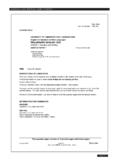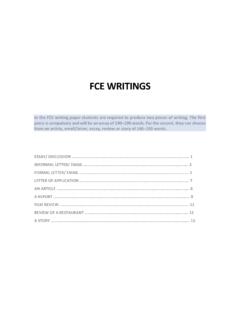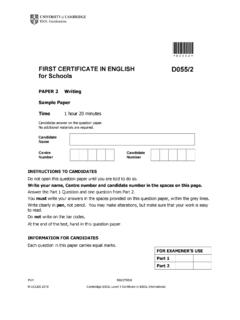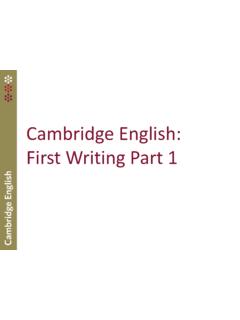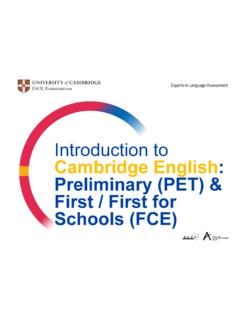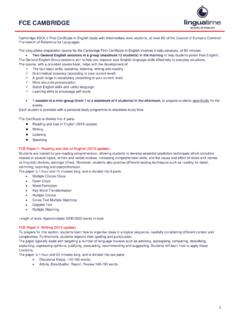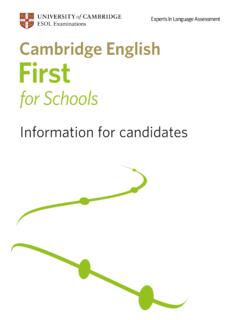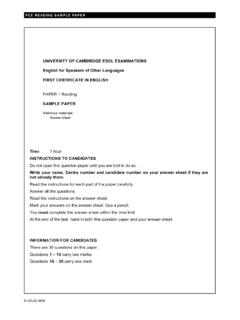Transcription of PAPER 2 WRITING - ILTEA
1 215fce examination | PAPER 2: writingGENERAL DESCRIPTIONP aper formatThe PAPER contains two hour 30 of parts of questionsCandidates are required tocomplete two tasks: a compulsory one in Part 1 and one from a choice of four in Part typesFrom the following: letters, articles, reports,compositions, task has a given purposeand a target format The questions are in a bookletwith lined pages for theanswers. The blank pages at the back of the booklet can be used for WRITING notes or finishing answers,if question on this papercarries equal AND TASKSPART 1 Task typeQUESTION 1and focusWriting a transactional letter (formal/informal).FormatCandidates are required to deal with inputmaterial of up to 250 words. This may includematerial taken from advertisements, extractsfrom letters, emails, postcards, diaries, shortarticles, of tasksOne compulsory length120 180 2 Task typeQUESTIONS 2 4and focusWriting one of the following: an article a non-transactional letter a report a discursive composition a short 5 WRITING one of the following, based on readingone from a prescribed list of five books: an article an informal letter a report a 5 has two situationally-based WRITING task specified in nomore than 70 of tasksFour tasks from which candidates choose length120 180 WRITING16fce examination | PAPER 2: writingThe two parts of the WRITING PAPER Each question on the WRITING PAPER carries equal marks.
2 Expected word lengthCandidates are asked to write 120 180 words for each answers that are below length, the examiner adjusts themaximum mark and the mark given proportionately. Foranswers that are over-length, the examiner draws a line at theapproximate place where the correct length is reached anddirects close assessment to what comes before this. However,credit is given for relevant material appearing later. IrrelevanceThe examiner s first priority is to give credit for thecandidate s efforts at communication, but candidates arepenalised for inclusion of content irrelevant to the task set. PART 1 COMPULSORY TASK This part tests the candidates ability to write a transactional letter,in response to a request for action or to initiate action. Sample question and scripts: pages 19 and 22 23. Task type and focusThe letter may be formal or informal.
3 The range of functions in this letter may include requesting and giving information,explaining, apologising, as well as making complaints,corrections, or suggestions. The usual conventions of letterwriting, specifically opening salutation, paragraphing andclosing phrasing, are required but it is not necessary to includepostal addresses. Candidates who do include addresses willnot be penalised. Task formatCandidates need to base their letter on input material of up to250 words. This input is made up of varied combinations oftext and notes, and may be supported by illustrations ordiagrams. The texts may include advertisements, extractsfrom letters, emails, postcards, diaries or short articles. Widelyused abbreviations, such as , , etc., may also appear aspart of the input. It is very important that candidates cover allthe essential points of the input in their answer so that thetarget reader is fully informed.
4 Candidates should be awarethat the overall aim of the task is to achieve a positive effecton the target reader. A list of questions or statements insimple sentences is not enough; organisation and cohesion,clear layout, appropriate register, control and accuracy oflanguage are all-important features of task evidence of range of language is also required, whichmeans building on key words from the input rather thanlifting whole segments. Part 1 tasks often offer the candidatesthe opportunity to add a piece of information, or make asuggestion or request of their own, and this enables them todemonstrate their range of language. PA RT 2 Task formatThe input for these five tasks is considerably less than in Part 1. Each WRITING task in Part 2 has a context, a purpose forwriting and a target reader specified in no more than 70words.
5 Widely used abbreviations, such as , , etc., mayalso appear, as in Part 1. Attention to every element in therubric is essential for effective task achievement andcandidates should also consider carefully whether the task isto be written in an informal or neutral/formal tone. PART 2 QUESTIONS 2 4 This part consists of four questions from which candidates mustchoose one. One of the four questions offers two options based on thelist of set books. Sample questions and scripts: pages 19 and 24 26. Task type and focusThe different task types are intended to provide frameworksfor the candidates so that they can put together and developtheir ideas on a topic with a purpose for WRITING and a targetreader in example:A COMPOSITIONis usually written for a teacher, perhaps as afollow-up to a class activity, and would probably include someopinions and suggestions on the ARTICLEis usually written for an English languagemagazine or newsletter.
6 The reader is assumed to have similarinterests to the writer. The main purpose is to interest andengage the reader, so there should be some opinion orcomment. Candidates may include some description REPORTis usually written for a superior (a boss or a teacher)or a peer group (club members, colleagues). Candidates will beexpected to give some factual information and make somesuggestions or recommendations of their own. A report shouldbe clearly organised and may include LETTER OF APPLICATIONis usually written to an individual oran organisation. The purpose is always clear (to get the job, thescholarship, etc.), and all information and expressions ofinterest are directed to that INFORMAL LETTERis written for a known reader, a penfriend. The aim is to interest the reader, share an experienceor explain feelings and personal SHORT STORYis usually written for an English languagemagazine or anthology.
7 The writer might be WRITING for a fee orin the hope of winning a prize, but the immediate purpose isto engage the interest of the examination | PAPER 2: writingThese indications of readership and purpose are notcomprehensive, but are intended to provide some guidelinesto the different task types. It must be stressed that specialisedwriting skills are not expected of candidates at this level. PART 2 QUESTIONS 5(A) AND (B)This consists of a choice of two tasks based on the list of set books,as specified in the Examination Regulations issued every year (alsoavailable through the Cambridge ESOL ). Sample questions and script: pages 19 and 27. Task type and focusThe tasks require one of the types of WRITING given above, , letter, composition or option is intended to encourage extended reading as abasis for the enrichment of language study, and a variety ofsimplified and original texts are included in the list ofprescribed titles.
8 Each book normally remains on the list fortwo to three who base their answer on another book not on thelist will receive Band 0. The questions are designed to begeneral enough to be applicable to any of the books. The targetreader is defined as someone who has probably not read thebooks. This encourages adequate reference to the text whichthe candidate has read; a plot summary is not, however, asubstitute for the Question 5, the examiners are looking for evidence thatcandidates have read and appreciated a set book and are ableto provide evidence of this in the form of description anddiscussion. Assessment is based, as for the other Part 2 tasks,on control of language in the given context. It is obviouslynecessary to downgrade candidates who attempt the set bookquestions without Candidates write most effectively when they choose tasksand topics well suited to their interests and experiences.
9 Whenpreparing students for the examination, it is important to makesure they are familiar with the PAPER and the range of task typesand topics so that they can identify those which are mostaccessible to them. Train your students to read the questions carefully,underlining the most important parts. They then need tomake a plan, referring closely to the question and looking foropportunities to develop their ideas and show their range oflanguage. The time allowed for the WRITING PAPER (1 hour 30 minutes)is designed to be sufficient for candidates to make brief plansand then write their two answers as clearly as possible. Theyshould not worry if they make mistakes but they should makeclear corrections so that the examiner can follow and markwhat they have written. Linking ideas effectively is also something your studentswill need guidance with.
10 Using a variety of linking words isimportant, as is ensuring that the flow of ideas in the writingis logical and easy for the reader to follow. If candidates write simple sentences throughout, theycannot be given good marks for range of language. It isimportant to use more complex language at this level and, if indoing so they make mistakes, the examiner will always try togive credit for the complex language attempted as long as themistakes do not impede communication. Counting words wastes time in an examination and canlead to clumsy alterations to what a candidate has alreadywritten. Your students will need practice in WRITING tasks atthis level within the word limit so that they know when theyhave written enough in their own handwriting. Make sure your students have practice in answering thequestions without the use of dictionaries.
